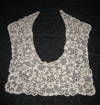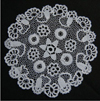Irish Crochet
|
 |
 |
 |
 |
 |
|||
 |
 |
 |
 |
||||
 |
|||||||
 |
 |
 |
 |
 |
 |
 |
|
 |
 |
||||||
 |
|||||||
 |
 |
 |
|||||
 |
 |
 |
 |
||||
 |
 |
 |
 |
 |
 |
||
 |
 |
 |
 |
 |
 |
 |
 |
 |
 |
 |
 |
 |
|||
 |
 |
 |
 |
 |
|||
 |
|||||||
 |
 |
 |
|||||
 |
Irish Crochet It isn't always easy to love Irish Crochet - it is a process that can take many years. Part of the problem is a lack of information. This is starting to change, and I've given some references that address the historical aspects below. Another reason is the proliferation of crochet as a home hobby, marketed in women's magazines almost since it's inception. Although many of these instructions are true to the complex spirt of the lace (see particularly the 'French Crochet' section of this website), other widely distributed material has been greatly simplified. If you start at enough examples long enough, and study design trends in original source material and modern works, patterns do become apparant. I've organized this index page to try and recognize some of those patterns. Much study is needed to try and associate stylistic trends with their manufacturers - or at least try to identify trends associated with various geographical areas in Ireland. The top first rows contain some of the earliest material, and also demonstrate how Irish Crochet can be used as a textile in itself. Small, dense motifs done in surprisingly fine thread give the product a lovely drape. The patterns stand by themselves, but also can be used as a background for bolder motifs. The second row continues this theme, but shows how the earlier more random work could be organized into the familiar Rose of Sharon pattern. The third row examines a number of pieces which combine Irish Crochet and needlelace - these were considered to be quite high end products. The next row looks at a more familiar form of Irish Crochet, involving large motifs against a variety of grounds. Some of the best involve use of the 'Clones knot', used singly or as a trefoil 'cloverleaf' decoration. Other beautiful grounds were often used. Motifs can range from the conventional to the bizaar, but in collecting this type of lace, one should always keep in mind the quality of execution. Tightly worked stitches in the motifs give the work almost a carved appearance. The use of linen versus cotton has a great affect on the end impression. Raised areas can show great innovation in technique. The last rows gather together examples that are very closely associated in Style, and likely have the best chance of attribution. The tightly 'crysanthumum'-like motifs of pieces in 5th row are combined with grounds of wonderful innovation. Unfortunately the design itself is, well, not all that it could be. Examples in the 6th row show Irish crochet in silk, of the 'geometric' style, and some lovely Art Nouveau pieces. The last row contains examples with a very dense pattern using just a few motifs. first posted 1/18/2009 |
